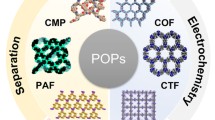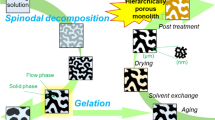Abstract
In this paper, the core–shell SiO2@mSiO2/CTAB spheres were fabricated by choosing the solid silica spheres of different sizes as the internal cores, then a series of etching experiments were conducted. For different etching time and particle size, different rattle-type or hollow silica spheres were obtained. Investigation showed that CTAB in the mesoporous shell played a very important role to the selectivity of the etching. Both the rattle-type and hollow structures were successfully fabricated by adjusting the etching time in the presence of CTAB but without obvious etching of mesoporous silica shell. More importantly, the morphology transformation depended on the particle size of the solid silica cores. Generally, when the particle size of the internal cores was very small (d < 170 nm), the hollow structure was first obtained even after being etched for a short time. When the particle size of the internal cores was slightly larger (200 nm < d < 500 nm), the rattle-type microspheres with double-shell structure were first obtained after being etched for a short time, then the hollow structure was obtained with prolonging etching time. But when the particle size of the internal cores was far larger (d > 1 μm), the rattle-type microspheres with at least double-shell structure were first obtained after a certain period of etching time, then the hollow spheres with multi-shell structure were obtained with prolonging etching time. It is further revealed that both the rattle-type and hollow silica spheres with multi-shell structure could be prepared successfully if the particle size of the solid silica core was large enough.
Graphical Abstract








Similar content being viewed by others
References
Anisur RM, Shin J, Choi HH, Yeo KM, Kang EJ, Lee IS (2010) Hollow silica nanosphere having functionalized interior surface with thin manganese oxide layer: nanoreactor framework for size-selective Lewis acid catalysis. J Mater Chem 20:10615–10621
Bastakoti BP, Li Y, Kimura T, Yamauchi Y (2015) Asymmetric block copolymers for supramolecular templating of inorganic nanospace materials. Small 11:1992–2002
Cao S, Fang L, Zhao Z, Ge Y, Piletsky S, Turner APF (2013) Hierarchically structured hollow silica spheres for high efficiency immobilization of enzymes. Adv Funct Mater 23:2162–2167
Chang F-P, Hung Y, Chang J-H, Lin C-H, Mou C-Y (2014) Enzyme encapsulated hollow silica nanospheres for intracellular biocatalysis. ACS Appl Mater Interfaces 6:6883–6890
Fang X, Zhao X, Fang W, Chen C, Zheng N (2013) Self-templating synthesis of hollow mesoporous silica and their applications in catalysis and drug delivery. Nanoscale 5:2205–2218
Fielding LA, Mykhaylyk OO, Schmid A, Pontoni D, Armes SP, Fowler PW (2014) Visible Mie scattering from hollow silica particles with particulate shells. Chem Mater 26:1270–1277
Gu H, Wang J, Ji Y, Wang Z, Chen W, Xue G (2013) Facile and controllable fabrication of gold nanoparticles-immobilized hollow silica particles and their high catalytic activity. J Mater Chem A 1:12471–12477
Guan Y, Meng X, Qiu D (2014) Hollow microsphere with mesoporous shell by pickering emulsion polymerization as a potential colloidal collector for organic contaminants in water. Langmuir 30:3681–3686
Guo N, Liang Y, Lan S, Liu L, Ji G, Gana S, Zou H, Xu X (2011) A mesoporous hollow silica sphere (MHSS): synthesis through a facile emulsion approach and application of support for high performance Pd/MHSS catalyst for phenol hydrogenation. Appl Surf Sci 257:4472–4477
Guo L, Zhang R, Chen C, Chen J, Zhao X, Chen A, Liu X, Xiu Y, Hou Z (2015) Gold nanoparticles embedded in silica hollow nanospheres induced by compressed CO2 as an efficient catalyst for selective oxidation. Phys Chem Chem Phys 17:6406–6414
Huang Y, Wei T, Yu J, Hou Y, Cai K, Liang X-J (2014) Multifunctional metal rattle-type nanocarriers for MRI-guided photothermal cancer therapy. Mol Pharm 11:3386–3394
Ji Q, Hill JP, Ariga K (2013) Shell-adjustable hollow ‘soft’ silica spheres as a support for gold nanoparticles. J Mater Chem A 1:3600–3606
Laohhasurayotin K, Viboonratanasri D (2013) Preparation and characterization of titania-entrapped silica hollow particles: effective dye removal and evidence of selectivity. Phys Chem Chem Phys 15:9626–9635
Li J, Qi J, Liu C, Zhou L, Song H, Yu C, Shen J, Sun X, Wang L (2014a) Fabrication of ordered mesoporous carbon hollow fiber membranes via a confined soft templating approach. J Mater Chem A 2:4144–4149
Li X, Zhou X, Guo H, Wang C, Liu J, Sun P, Liu F, Lu G (2014b) Design of Au@ZnO yolk-shell nanospheres with enhanced gas sensing properties. ACS Appl Mater Interfaces 6:18661–18667
Li W, Jia X, Li P, Zhang B, Zhang H, Geng W, Zhang Q (2015) Hollow mesoporous SiO2-BiOBr nanophotocatalyst: synthesis, characterization and application in photodegradation of organic dyes under visible-light irradiation. ACS Sustain Chem Eng 3:1101–1110
Lin W-I, Lin C-Y, Lin Y-S, Wu S-H, Huang Y-R, Hung Y, Chang C, Mou C-Y (2013) High payload Gd(III) encapsulated in hollow silica nanospheres for high resolution magnetic resonance imaging. J Mater Chem B 1:639–645
Liu G, Cai M, Zhou F, Liu W (2014) Charged polymer brushes-grafted hollow silica nanoparticles as a novel promising material for simultaneous joint lubrication and treatment. J Phys Chem B 118:4920–4931
Nandiyanto ABD, Akane Y, Ogi T, Okuyama K (2012) Mesopore-free hollow silica particles with controllable diameter and shell thickness via additive-free synthesis. Langmuir 28:8616–8624
Okada T, Ozono S, Okamoto M, Takeda Y, Minamisawa HM, Haeiwa T, Sakai T, Mishima S (2014) Magnetic rattle-type core-shell particles containing iron compounds with acid tolerance by dense silica. Ind Eng Chem Res 53:8759–8765
Okamoto M, Tsukada H, Fukasawa S, Sakajiri A (2015) Synthesis of hollow and rattle-type mesoporous silica spheres by treating layered mesoporous silica with a basic solution, and using the spheres as microreactors for two-phase reactions. J Mater Chem A 3:11880–11890
Pan D, Shi G, Zhang T, Yuan P, Fan Y, Bao X (2013) New understanding and controllable synthesis of silica hollow microspheres with size-tunable penetrating macroporous shells as a superior support for polystyrene hydrogenation catalysts. J Mater Chem A 1:9597–9602
Ren L, Simmons TJ, Lu F, Rahmi O, Kotha SP (2014) Template free and large-scale fabrication of silica nanotubes with centrifugal jet spinning. Chem Eng J 254:39–45
Ruckdeschel P, Kemnitzer TW, Nutz FA, Senker J, Retsch M (2015) Hollow silica sphere colloidal crystals: insights into calcination dependent thermal transport. Nanoscale 7:10059–10070
Sharma M, Das D, Baruah A, Jain A, Ganguli AK (2014) Design of porous silica supported tantalum oxide hollow spheres showing enhanced photocatalytic activity. Langmuir 30:3199–3208
Shi Y, Takai C, Shirai T, Fuji M (2015) Facile synthesis of hollow silica nanospheres employing anionic PMANa templates. J Nanopart Res 17:1–10
Su Y, Yan R, Dan M, Xu J, Wang D, Zhang W, Liu S (2011) Synthesis of hierarchical hollow silica microspheres containing surface nanoparticles employing the quasi-hard template of poly(4-vinylpyridine) microspheres. Langmuir 27:8983–8989
Teng Z, Su X, Zheng Y, Sun J, Chen G, Tian C, Wang J, Li H, Zhao Y, Lu G (2013) Mesoporous silica hollow spheres with ordered radial mesochannels by a spontaneous self-transformation approach. Chem Mater 25:98–105
Tsou C-J, Chu C-Y, Hung Y, Mou C-Y (2013) A broad range fluorescent pH sensor based on hollow mesoporous silica nanoparticles, utilising the surface curvature effect. J Mater Chem B 1:5557–5563
Wan H, Long Y, Xu H, Song K, Yang G, Tung C-H (2014) New strategy to prepare hollow silica microspheres with tunable holes on the shell wall. Langmuir 30:683–686
Wang C, Yan J, Li Z, Wang H, Cui X (2013a) Investigation on raspberry-like magnetic-hollow silica nanospheres and its preliminary application for drug delivery. J Nanopart Res 15:1–14
Wang Y, Su X, Ding P, Lu S, Yu H (2013b) Shape-controlled synthesis of hollow silica colloids. Langmuir 29:11575–11581
Wu X, Tan L, Chen D, Meng X, Tang F (2014) Icosahedral gold–platinum alloy nanocrystals in hollow silica: a highly active and stable catalyst for Ullmann reactions. Chem Commun 50:539–541
Yildirim A, Bayindir M (2015) A porosity difference based selective dissolution strategy to prepare shape-tailored hollow mesoporous silica nanoparticles. J Mater Chem A 3:3839–3846
Yin Y, Wei G, Zou X, Zhao Y (2015) Functionalized hollow silica nanospheres for His-tagged protein Purification. Sens Actuat B 209:701–705
Yu Q, Wang P, Hu S, Hui J, Zhuang J, Wang X (2011) Hydrothermal synthesis of hollow silica spheres under acidic conditions. Langmuir 27:7185–7191
Zhang Y, Hsu BYW, Ren C, Li X, Wang J (2015) Silica-based nanocapsules: synthesis, structure control and biomedical applications. Chem Soc Rev 44:315–335
Acknowledgments
The authors are grateful to the National Natural Science Foundation of China (No. 51173146 and No. 21201140), Basic Research Fund of Northwestern Polytechnical University (3102014JCQ01094, 3102014ZD), NPU Foundation for Graduate Innovation for the financial support.
Author information
Authors and Affiliations
Corresponding authors
Rights and permissions
About this article
Cite this article
Li, W., Tian, Y., Zhao, C. et al. Investigation of selective etching mechanism and its dependency on the particle size in preparation of hollow silica spheres. J Nanopart Res 17, 480 (2015). https://doi.org/10.1007/s11051-015-3291-z
Received:
Accepted:
Published:
DOI: https://doi.org/10.1007/s11051-015-3291-z




